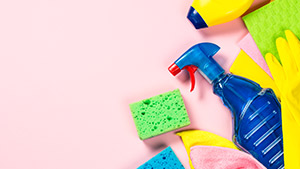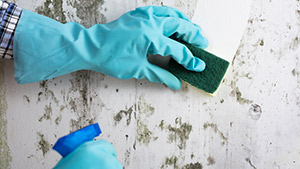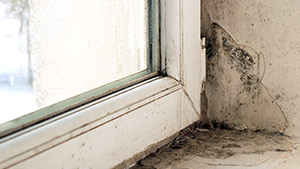
If You Have a Small Outbreak of Mold, Something Already in Your Cabinet May Do the Trick.
Mold: the most frustrating of fungi. When it pops up in your shower’s grout or on your kitchen sink, you want to scrub it away fast. And you can probably handle small mold outbreaks yourself with what you have in your kitchen cabinet. But when the job is too big for you to clean yourself, call CLEAR Restoration and let us handle your mold problem for you.
 When it’s Okay to Clean Mold Yourself
When it’s Okay to Clean Mold Yourself
Many household owners enjoy do-it-yourself projects. You can learn a new skill, feel accomplished at a job well done, and sometimes save money. Mold, however, is a tricky fungus. Mold establishing residence in your home can lead to minor or major health problems, and extended exposure can lead to lasting effects. Deciding if you can handle a mold problem yourself is an important decision. Small bouts of mold can be relatively safe to handle when you take the right precautions. Here are the instances when you should be able to manage the problem yourself:
- If the mold only covers a small area.
- If the mold is on non-porous surfaces that are easy to clean, such as glass, metal, tile, tubs, or sinks.
- If you don’t have any health problems likely to be made worse by increased mold exposure (you should check with your doctor if you’re not sure).
 Cleaning Up the Funky Fungus
Cleaning Up the Funky Fungus
If you decide cleaning up the mold yourself is the best solution for you, vinegar and baking soda are fantastic for mold clean-up. White-distilled vinegar is mildly acidic and has been shown to kill types of mold. Vinegar is free of chemicals, so it is environment-friendly and safe for people and pets. Baking soda can be added to vinegar to tackle different types of mold as it kills different mold strains. Baking soda is as environmentally friendly as vinegar, too. Here are the steps to cleaning mold with vinegar and baking soda:
- Safety First! Be sure to wear a safety mask, goggles, and gloves to prevent direct exposure to the mold. Don’t skip the mask, mold spores often contaminate the air and can cause allergic reactions.
- Pour white-distilled vinegar directly into a spray bottle.
- Spray the vinegar directly onto the mold and allow it to sit for one hour without rinsing or scrubbing. This gives the mold time to absorb the vinegar.
- If scrubbing is not necessary, rinse the area with warm water and allow the surface to dry.
- If scrubbing is necessary, combine one teaspoon of baking soda with two cups of water in a spray bottle and shake until mixed.
- Spray the baking soda solution directly onto the mold and scrub vigorously with a scrubbing brush or scouring pad.
- Rinse the area with clean, warm water.
- Spray the area again with the vinegar solution and let the area dry naturally to kill any remaining mold and prevent regrowth.
 When It’s Best to Call in the Professionals
When It’s Best to Call in the Professionals
When you aren’t sure if you can handle the mold problem yourself, it may be best to call in the experts. Mold is difficult to deal with, especially if it’s on your walls or ceiling. Mold can hide behind walls and become a huge infestation. If left unchecked, mold can migrate into multiple rooms in the house and go from being an inconvenience to a gigantic problem. The risks to your family’s health include allergies, fatigue, coughing, sinus problems, and more.
Sometimes, wood has to be sanded or drywall replaced, and it’s just better for everyone if you leave that daunting project to us. CLEAR Restoration can help you if you are experiencing a mold problem bigger than you can handle. You should call CLEAR Restoration if:
- The mold covers a large area.
- Mold is growing on your walls, ceiling, or floors.
- There is mold in your heating, ventilation, and air conditioning system.
- Mold develops after flooding, especially from water that might be contaminated with sewage or other potentially hazardous substances.
- You can smell the mold but can’t find it.
- You are already experiencing symptoms of mold-related illness, such as sneezing, coughing, runny nose, shortness of breath, wheezing, headaches, sore throat, or chronic sinus infection.
- You aren’t sure if you can do all parts of the job correctly.
- You have a medical condition that could be worsened by increased exposure to mold.
When you have a mold problem, there are many factors to consider. Effectively killing and completely removing the mold should be your top priority. If you’re dealing with a large mold contamination, hire a professional mold remediation company for your safety and peace of mind. Call CLEAR Restoration today for safe, professional mold remediation.



